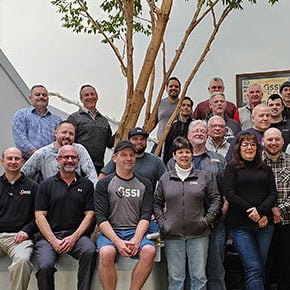Using GPR Scanning Prior To Concrete Cutting Saves Money and Avoids Hazardous Conditions
There has been so much discussion in the construction industry on how important it is to identify metal targets and electrical lines before cutting into concrete. Yet every day there are stories about mishaps that happen when contractors don’t accurately mark the location of rebar, post-tension cables, and conduits in concrete structures before they start drilling, cutting, coring, trenching, or digging.
What’s at stake? If embedded or buried obstructions are hit during concrete cutting, the results can be disastrous – from project delays, cost overruns, to worker hazards. Cutting rebar that is strengthening the slab steel beam structure could cause damage – or even cause the structure to fall. Cutting electrical conduit can result in a job shut down or cause serious injuries.
In this post, a few of the country’s most expert concrete cutting firms weigh in on how scanning concrete using ground penetrating radar (GPR) helps with problem solving and avoiding potential problems. They are unanimous in their agreement that GPR scanning is the best way to avoid damage claims and potential safety hazards. I also offer a few tips for best practices on using GPR for concrete scanning.
X-Ray Technology Just Does Not Cut It Anymore
For many decades, X-ray technology was the go-to non-destructive technique used to locate and identify embedded targets. Most experts now agree that GPR concrete scanning is the most efficient process, because it lets personnel work more quickly, efficiently, and accurately in real-time. And just as important, because GPR is not radioactive, personnel can work safely around other construction trade workers on the jobsite. GPR equipment is also more affordable and much easier to use than X-ray technology.
Emily Hammer, of Chicago-based Hard Rock Technologies, explains that Hard Rock uses GPR to locate structural reinforcement and anomalies, void detection, and locating conduits. The firm’s work has included investigations for the Willis Tower (formerly the Sears Tower), the John Hancock Tower, and Wrigley Field.
“Scanning concrete with GPR may cause some minor delays, but it results in a better product and avoids much longer delays that would happen from hitting a water main or causing a conduit to shut off. It also helps avoid the cost of damaged structure and pipes and the time spent repairing them.”
Another example comes from Matt Aston of Ground Penetrating Radar Systems Inc. (GPRS), located in Toledo, Ohio, which has worked on some of the largest jobs in the United States, including the new Freedom Tower, professional sports stadiums, and Disney properties.
At one site he is familiar with, the contractor was working on what should have been a simple job to cap a hospital sanitary line. A concrete cutting firm used a jackhammer to break through a wall to cap the line. Unfortunately, an electrical closet was on the other side of the wall. More than twenty electrical conduits were running through it – and all were broken or destroyed. The hospital had to shut down the power to the kitchen and make catering arrangements for several meals before kitchen power was restored. “The hospital president called me to a meeting to ask what it would have cost to scan the area,” says Aston. “I told him it would have cost in the range of $600-700. Instead, their spending for electrical repairs and food was around $200,000.”
Follow Best Practices
While not perfect, GPR scanning helps contractors uncover hazards and avoid the enormous cost and inconvenience of interrupting services to the building or operations. To get the most from GPR, follow these best practices:
Select the Right Equipment
GPR equipment for scanning concrete takes a beating, so it must be durable and rugged. It should also be easy to use, with an intuitive and bright display and high image resolution.
Use GPR to Determine Location and Depth of Obstructions to Avoid
Prior to concrete cutting, use GPR to determine the location and depth of rebar, conduit, and any other obstructions to avoid. This information allows the operator to know what can be cut, the depth of the cut, and what locations to avoid.
Follow Concrete Sawing and Drilling Association (CSDA) Guidelines
The American Society for Nondestructive Testing (ASNT) and the Concrete Sawing and Drilling Association (CSDA) is developing an industry-wide training/certification. This will include concrete scanning best practices that can be used when developing a scope of work that requires concrete cutting. Check out the CSDA site and start using the proposed best practices right away.
Maintain Good Communication with Imaging Contractor
Be sure to maintain good communication with the imaging contractor to avoid misinterpretations of data. This is so important, especially because there is not yet a standardized marking system – one scanner’s marks may look different from another’s. CSDA is also trying to standardize the markings, but even when that is done, communication would still be important so all parties have an understanding of what is going on. In addition, proposed CSDA standards call for the imaging contractor to do a follow up walk through on the jobsite to ensure the job is done to their understanding.




